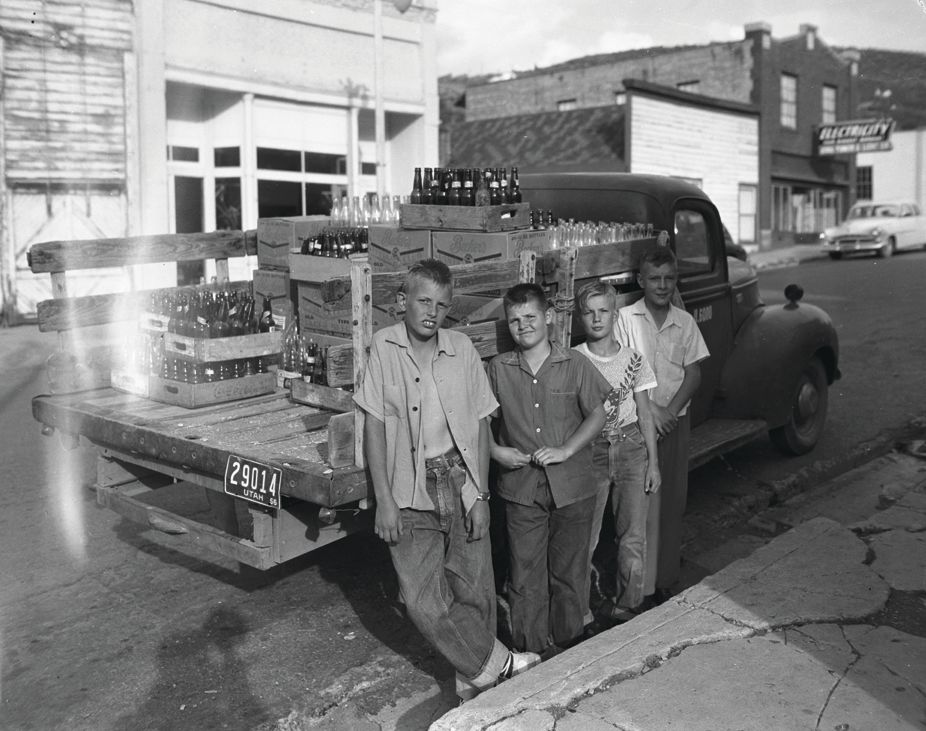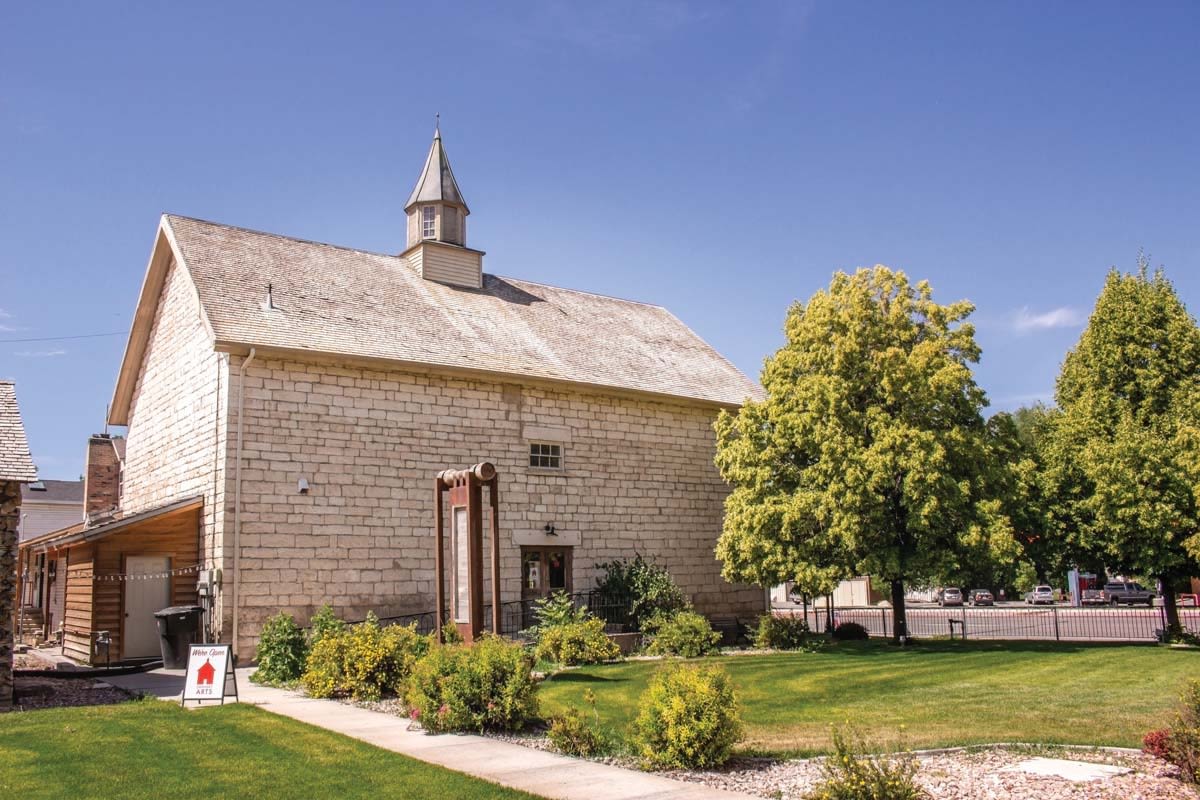How Park City Survived the Ghost Town Years of the 1950s

Kent Sundquist, Gary Reed, George Stratham, and Karl Cossey on the 500 block of Main Street, circa 1956
Image: Park City Museum
Must Park City become a Ghost Camp?” screamed Park Record headlines in 1950, a year after crashing silver prices forced the mines—the town’s lifeblood—to shut down, putting 1,200 people out of work. Once a booming town of 7,000, Park City’s population fell to 2,254 in 1950 and to 1,366 by the decade’s end. The town, as Time magazine prophesized, “was destined to become an abandoned ghost town.” But Park City proved the dire predictions false—even when it showed up in the guidebook Ghost Towns of the West.
“The state of Utah basically told Parkites to leave. They said it was no longer a viable community,” recalls Park City native Jim Weaver. Ever rebellious, many Parkites chose to stay put. Having survived fires, avalanches, explosions, and catastrophic mine disasters, a small band of determined Parkites toughed out the 1950s with resourcefulness, teamwork, and sheer grit.
Down and Out
The outside world didn’t waste time shining a light on Park City’s woes. The Deseret News gave its front page to “the plight” of Park City with grim photos as evidence. A television station showed up to ask, “Do you believe Park City is to become a ghost town?” Artists from Salt Lake City arrived to paint the dilapidated houses. And when the Salt Lake Tribune published a special “Western Wonderland” section with a map of Summit County, Park City wasn’t even on it.
To add insult to injury, in 1955, state and county law enforcement, with reporters in tow, raided Main Street to “clean up” the mining camp. Ten people were arrested from taverns and a house of ill repute. The town’s furious mayor, Earle Reseigh, complained to the governor, calling the raid illegal and protesting the unfair publicity. But such scorn wasn’t new to the hardy Parkites. “We were always being looked down upon by outsiders,” recalls Mary Lou Toly, a lifelong resident. Weaver concurs, “Utah mining towns were seen as rebellious, full of renegades. That attitude just steeled the residents together.”
The city struggled to stay afloat. When the Tax Anticipation Loan didn’t come through for the first time in the town’s history, the mayor proclaimed, “If you want a thing done, do it yourself.” As city workers were laid off, the police deputized volunteers, clubs raised money to patch up sidewalks, local mechanics pitched in to fix city vehicles, and citizens repaired the fence in the cemetery where cattle were roaming. By the mid ’50s, the city was down to a single fire truck, police car, snowplow, school bus, and Army surplus garbage truck that had the habit of catching on fire from the ashes it hauled.
Donna Dearden, who moved into the Union Pacific Depot with her station agent husband in 1957, remembers the hardship—and resiliency—of the times; she recalls that “much of Main Street was boarded up, and many children didn’t have boots, even in the deep snow.” By then, 58 businesses were torn down or vacant on Main Street, including the barbershop and the department store. School enrollment severely declined and teachers left town. The 69-member class of ’59 numbered 20 by graduation. But Marsac Elementary and Park City High School never closed. Folks feared the hospital would close, but it also survived. The city library, with old books piled to the ceiling, became a dumping ground as people abandoned town.
Citing the mass exodus, a Record writer scolded, “Don’t be ashamed of your town! We have plenty of real estate for sale at ridiculously low prices!” But no one was buying. Ironically, when one developer approached the only bank in town, Dearden (who worked at the bank) recalls, “he decided the network of underground mine tunnels would never support development above ground.”
In order to “put Park City back on the map,” Mayor Reseigh championed a “Better Park City” crusade. National Guard engineers graded a scenic road to Brighton and locals erected a homemade 10-by-14-foot sign on Highway 40 proclaiming “Visit Park City Historic Mining Camp 1869.” But the sign couldn’t hide the town’s shabbiness. So, the city council tackled the matter of dilapidated “old cars laying around” and offered $25 to the first Main Street business to paint its building. A “Progressive Club” sponsored a scrap metal drive and regatta on the Rockport Reservoir to fund revitalization projects: planting grass at the ballpark, cleaning up vacant lots, and tearing down abandoned buildings.
The Tough Stay Put
“It was fascinating, the group of people who stayed during the 1950s,” says Herb Armstrong, who summered at his grandfather’s Snow Summit Ranch. “There were some real characters; they were strong and resilient.” Miners who didn’t leave found out-of-town construction jobs or took in boarders. “You couldn’t get a loan, says Weaver, so Parkites salvaged pipes, electrical parts, and even nails from the shuttered mines for home improvements. “We all stuck together,” says Weaver. “We always said we would take care of our own.”
Social and civic organizations spearheaded efforts to make ends meet—and stir up a little fun. The 4-H and Homemaker’s Clubs held classes in everything from darning socks to making furniture out of powder boxes from the mines. And the community gathered for dances, dinners, and bowling leagues. Toly remembers movies on Saturdays at the Egyptian Theatre (with a drawing for a $25 prize) and the annual football rivalry, the “lower enders,” who lived above Eley Garage (on the corner of Main Street and Park and Heber avenues), versus the “upper enders.”
Two key institutions, the Park Record (which never missed a weekly issue) and the telephone company, held the community together. Toly, who started as an operator in 1955, explains, “There were no dial telephones. We would say, ‘Number please’ and when they gave three digits, we would connect them.” Operators also rang the Ten O’Clock Whistle; alerted police with a red light in City Hall; and acted as the town dictionary, fact finder, and encyclopedia. “The operators knew everyone’s business,” says Armstrong. “They could tell you if your girlfriend was going out with someone else.”
During hard times, the town took special care of its children, rallying together to make holidays memorable. At Miner’s Day (Labor Day) and Fourth of July, every child in the parade would receive a dime. At Christmastime, there was a tree in the park by the post office and Santa at the Memorial Building. Local clubs and organizations put out the call for winter coats and toys for children. The city even designated “Coasting Lanes,” streets where kids could ride sleighs. “We could sled all the way from the top of Empire Avenue on our Flexible Flyers,” recalls Toly.
Though jobs were scarce, kids “looked for ways to earn a few pennies by cutting Christmas trees, collecting bottles to turn in at Coffee John’s, or delivering the Record,” remembers Weaver. Armstrong recalls driving a tractor down the tracks of the old Crescent Tram to cut kindling to sell, while Toly earned 50 cents per hour at Pop Jenks café.

Park City escaped its 1950s slump thanks to ski industry investment, including Treasure Mountain Ski Area (today Park City Mountain), pictured here circa 1963.
Snow’s Silver Lining
Throughout the ’50s, winter sports flourished. Townies skied in their backyards and soared off the Creole Mine dump’s ski jump. Snow Park, a little ski area that had grown up on a Deer Valley hillside (where Otto Carpenter and Bob Burns built Utah’s first chairlift in 1946) was open on weekends—offering everything from Mel Fletcher’s ski school and costume races to equipment clinics and 50-cent ski films. “The snow [at Snow Park] was so deep, your knees would be under your chin because the chair would almost be touching the snow,” reflects Armstrong. When Carpenter thanked the city for expanding his parking lot, the mayor replied, “We are hopeful that this area may someday become a ski resort.”
In 1957, the Record reported, “Enthusiasm is growing for the great sport of skiing in our community.” A year later, New York Times headlines announced, “Utah Miners Eye Tourist Business,” as mining executives gauged snow depths and surveyed the idle Silver King Tramway to determine if it could carry skiers. By 1962, United Park had applied for a $1,232,000 Federal loan to build a ski resort. Salt Lake Tribune publisher Jack Gallivan goaded his friend Jack Kennedy to push through the loan’s approval. A year later, Treasure Mountain Resort opened. Park City—the ghost town that almost was—had survived the ’50s.
And, instead of gloomy predictions came words of encouragement. “To me, Park City always appeared to have tremendous potentialities,” wrote Reverend Francis Wisniewski to his flock. “From the world’s largest silver mine, it can become the world’s largest and finest summer and winter resort. Park City was built on rock, and not on sand.”

































